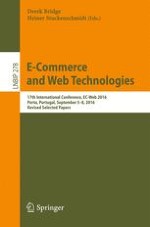2017 | Buch
E-Commerce and Web Technologies
17th International Conference, EC-Web 2016, Porto, Portugal, September 5-8, 2016, Revised Selected Papers
herausgegeben von: Derek Bridge, Heiner Stuckenschmidt
Verlag: Springer International Publishing
Buchreihe : Lecture Notes in Business Information Processing
